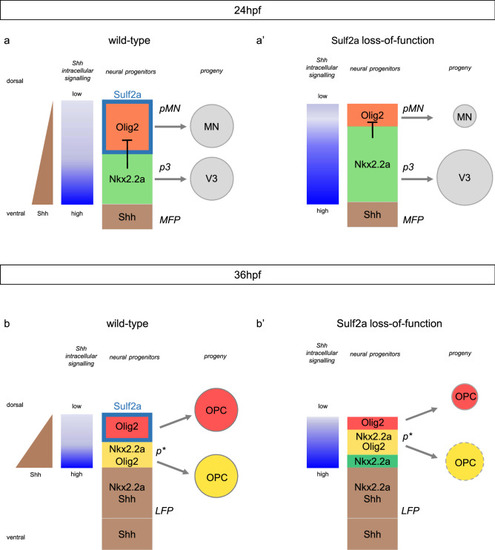
Model for Sulf2a function. Scheme showing Sulf2a and Shh-dependent gene expression in ventral neural progenitors during neuronal production (24 hpf, a,a’) and at the onset of gliogenesis (36 hpf, b,b’) in wild-type (a,b) and sulf2a depleted (a’,b’) contexts. In 24 hpf wild-type embryos (a), the ventral-most progenitors of the p3 domain (green), adjacent to the medial floor plate (MFP, brown), express the high-threshold Shh responsive gene Nkx2.2a and generate V3 interneurons. Sulf2a (turquoise blue frame), expressed in dorsally located Olig2/pMN progenitors (red), limits the dorsal extent of high-threshold Shh response to prevent activation of Nkx2.2a and thus allows maintenance of Olig2 expression (red) required to orient these cells toward the MN lineage. When sulf2a is depleted (a’), the range of high-threshold Shh response extends dorsally, leading to dorsal misexpression of Nkx2.2a which in turn represses Olig2. Subsequent changes in the sizes of the p3 and pMN domains cause overproduction of V3 interneurons at the expense of MNs. In 36hpf wild-type embryos (b), the Shh source has expanded in the former Nkx2.2a/p3 domain to form the lateral floor plate (LFP, brown). Immediately adjacent progenitors, i.e. the ventral-most cells of the Olig2/pMN domain, because they activate high-threshold Shh response, upregulate Nkx2.2a. At that stage, Nkx2.2a no more represses Olig2, leading to formation of the p* domain (yellow), populated by progenitors co-expressing Olig2 and Nkx2.2a. Sulf2a expression (turquoise blue frame) is excluded from p* cells but maintained in dorsally located Olig2 progenitors (red) where the enzyme, again, prevents high-threshold Shh response. Then, the two distinct populations of Olig2 progenitors, expressing Nkx2.2a (yellow) or not (red) generate the myelinating (yellow) and non-myelinating (red) OPC, respectively. In 36 hpf sulf2a-depleted embryos (b’), LFP formation is not affected but, because of the dorsal expansion of the Nkx2.2a/p3 domain that occurred at earlier stage, the dorsally adjacent progenitors express Nkx2.2a but not Olig2 (green), in contrast to the wild-type situation. Nonetheless, Sulf2a depletion, again, allows activation of high-threshold Shh response that causes dorsal misexpression of Nkx2.2a. Subsequently, the p* domain (yellow), while positioned dorsally, forms properly but, the reduced size of the Olig2/pMN domain leads to a deficit in progenitors that only express Olig2 and, consequently to a strong reduction in the population of non-myelinating OPCs (red). It has to be noted that the population of myelinating OPC (yellow) is also mildly reduced possibly due to a secondary effect of aberrant neuronal populations (see discussion).
|

